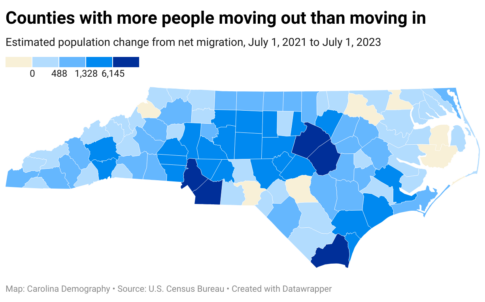75 NC counties have grown in population since 2022

Last week, the U.S (United States). Census Bureau released 2023 county population estimates. These annual estimates tell us how county populations in North Carolina have changed over the course of a year: in this case, between July 1, 2022 and July 1, 2023.
The county population estimates are more granular than the statewide estimates released every December. In the most recent state population estimate, released in December 2023, North Carolina’s population increased by 1.3% (139,526 residents). Most of this increase was due to net migration (more people moved to North Carolina than people moving out of North Carolina).There were also more births in the state than deaths, likely due to a decrease in deaths due to COVID-19.
The counties with the largest population increases were in coastal areas and in the Charlotte and Triangle suburbs. The fastest growing county was Brunswick County (4.6%) followed by Pender (4.3%), Franklin (3.5%), Johnston (3.0%), and Union (2.9%) counties. Twenty-six counties had higher population growth than the state (above 1.3%). These include:
Out of the 15 counties that experienced population loss, more than half of them were in the Northeast. The largest population loss was in Hyde County (-1.1%), followed by Hertford, Halifax, and Bertie (all at -0.9%), and Northampton (-0.7%) counties. A few counties in the south and the northwest also experienced population loss.
In North Carolina overall, there was a natural increase in the population between 2022 and 2023, meaning that there were fewer deaths than births. Most counties, on the other hand, experienced natural decreases in the population – fewer births than deaths. The largest natural decreases were in Brunswick County (-794), Henderson County (-520), Carteret County (-502), and Caldwell County (-475). Currituck County (+2), Alamance County (+18), and Lee County (+32) had small margins indicating that they might experience natural decreases in coming years.
The largest population increases due to net-migration were seen in Wake County and its suburbs (e.g., in Johnston County), in Mecklenburg County and the Charlotte suburbs (e.g., Union and Iredell counties), and at the coast (e.g., in Brunswick and New Hanover counties). Seven counties, Cumberland, Halifax, Watauga, Richmond, Hertford, Hyde, Tyrrell, experienced net out-migration. Of these, only one county experienced population growth between 2022 and 2023 – Cumberland County. Cumberland County was the only county that experienced population growth due to natural increase (more births than deaths) rather than net in-migration.
Between April 1, 2020 and July 1, 2023, the pattern has been the same. The population growth in most counties stems from people moving in rather than more births than deaths. In that time, 81 counties experienced population growth and only one county, Cumberland County, grew because of natural increase. North Carolina, overall, also experienced population growth due to net in-migration rather than natural increase between 2020 and 2023, following a pattern of in-migration as the main source of population growth in North Carolina.
Need help understanding population change and its impacts on your community or business? Carolina Demography offers demographic research tailored to your needs.
Contact us today for a free initial consultation.
Contact UsCategories: Migration, NC in Focus

The Center for Women’s Health Research (CWHR) at the University of North Carolina School of Medicine released the 12th edition of our North Carolina Women’s Health Report Card on May 9, 2022. This document is a progress report on the…

Dr. Krista Perreira is a health economist who studies disparities in health, education, and economic well-being. In collaboration with the Urban Institute, she recently co-led a study funded by the Kate B. Reynolds Foundation to study barriers to access to…

Our material helped the NC Local News Lab Fund better understand and then prioritize their funding to better serve existing and future grant recipients in North Carolina. The North Carolina Local News Lab Fund was established in 2017 to strengthen…
Your support is critical to our mission of measuring, understanding, and predicting population change and its impact. Donate to Carolina Demography today.